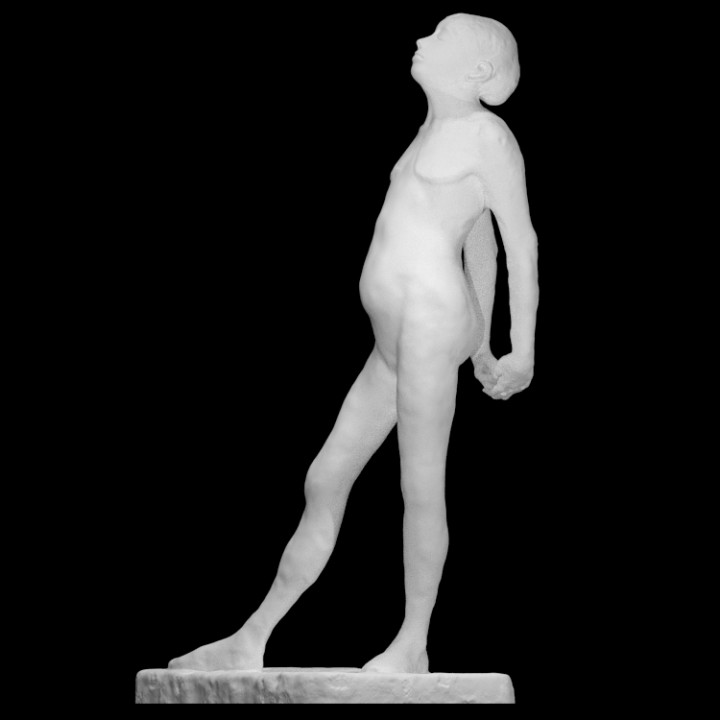
The Little Fourteen-Year-Old Dancer at The Réunion des Musées Nationaux, Paris
myminifactory
The Little Fourteen-Year-Old Dancer (French: La Petite Danseuse de Quatorze Ans) is a c. 1881 sculpture by Edgar Degas of a young student of the Paris Opera Ballet dance school, a Belgian named Marie van Goethem. The sculpture is two-thirds life size and was originally sculpted in wax, an unusual choice of medium for the time. It is dressed in a real bodice, tutu and ballet slippers and has a wig of real hair. All but a hair ribbon and the tutu are covered in wax. The 28 bronze repetitions that appear in museums and galleries around the world today were cast after Degas' death. The tutus worn by the bronzes vary from museum to museum. The exact relationship between Marie van Goethem and Edgar Degas is a matter of debate. It was common in 1880 for the "Petits Rats" of the Paris Opera to seek protectors from among the wealthy visitors at the back door of the opera. The arms are taut, and the legs are quite twisted round, and there is tension in the pose, an image of a ballerina being put through her paces, not posing in an angelic way. Her face is – "contorted, people thought it was a deliberate image of ugliness, but you could also say it's the image of a sickly gawky adolesecent who is being made to do something she doesn't totally want to do."When the La Petite Danseuse de Quatorze Answas shown in Paris at the Sixth Impressionist Exhibition of 1881, it received mixed reviews. Joris-Karl Huysmans called it "the first truly modern attempt at sculpture I know'. Certain critics were shocked by the piece, and the dancer was compared to a monkey and an Aztec. One critic, Paul Mantz, called her the "flower of precocious depravity," with a face "marked by the hateful promise of every vice" and "bearing the signs of a profoundly heinous character." Comparisons with older art were made, perhaps partly because it was exhibited in a glass case, like classical sculpture in the Louvre, and was dressed in wig and clothes. After Degas' death, his heirs (brother and sister's children) made the decision to have the bronze repetitions of Le Petite Danseuse and other wax and mixed-media sculptures cast. The casting took place at the Hébrard foundry in Paris from 1920 until the mid-20th century. Sixty-nine of Degas's wax sculptures survived the casting process. One copy of Le Petite Danseuse is currently owned by the creator and owner of Auto Trader, John Madejski. He stated that he bought the sculpture by accident. That copy was sold for £13,257,250 ($19,077,250) at Sotheby's on February, 3rd 2009. Another casting failed to sell at a November 2011 auction at Christies. To construct the statue, Degas used a lead pipe armature and, to some extent, paintbrushes for structural support. This object is part of "Scan The World". Scan the World is a non-profit initiative introduced by MyMiniFactory, through which we are creating a digital archive of fully 3D printable sculptures, artworks and landmarks from across the globe for the public to access for free. Scan the World is an open source, community effort, if you have interesting items around you and would like to contribute, email stw@myminifactory.com to find out how you can help.
With this file you will be able to print The Little Fourteen-Year-Old Dancer at The Réunion des Musées Nationaux, Paris with your 3D printer. Click on the button and save the file on your computer to work, edit or customize your design. You can also find more 3D designs for printers on The Little Fourteen-Year-Old Dancer at The Réunion des Musées Nationaux, Paris.
